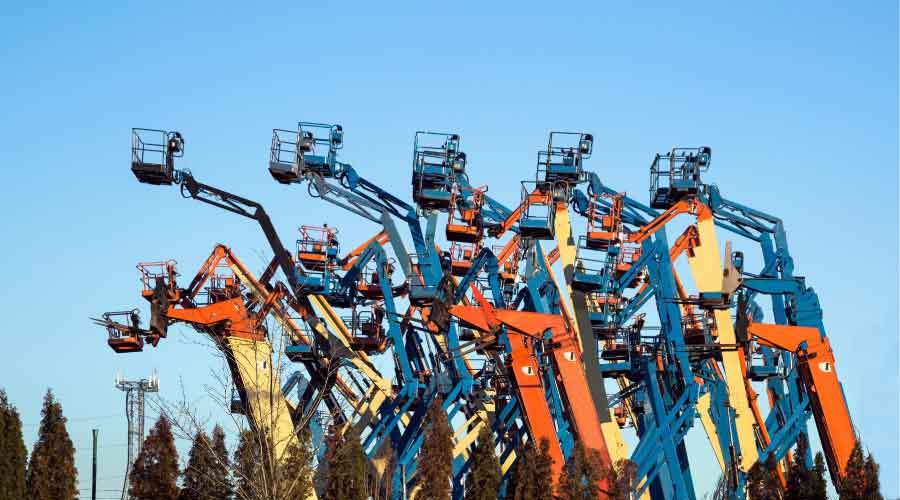Hazmat Management: Tools of the Trade
The right combination of containers, shelving, labels and protective equipment can keep workers and facilities safe
Managing hazardous materials and chemicals can be daunting, in part because of the large array of such materials within many institutional and commercial facilities. Managing these materials often becomes easier when managers take inventory of hazardous materials and chemicals and understand the dangers and regulatory requirements that apply to them.
Equally important, however, is having the equipment and supplies to successfully implement the management plan and, ultimately, provide a safer workplace.
Inventory Chemicals
Typical hazardous materials and chemicals that should be accounted for include mercury-containing equipment, lubricants, fuels, paints, glues, adhesives, compressed gases, cleaning solvents, laboratory chemicals, batteries, pesticides, coolants and refrigerants.
A hazardous materials and chemical management program can help managers and staffs store and handle these products safely and efficiently. In addition to having an accurate inventory of all materials, essential components of a management program include conducting periodic inspections, using proper containers and storage, and planning for emergencies.
Taking inventory starts with a department-by-department, room-by-room inspection to identify mercury-containing instruments, radioactive materials, solutions, chemicals, gas cylinders, pesticides, refrigerants, and unlabeled containers containing chemicals. Managers should develop a computerized inventory using either a spreadsheet or chemical inventory software, which allows for a more powerful analysis and easier way of tracking inventory. Software can help manage material safety data sheets, databases of regulated substances, and regulatory-compliance tasks.
Workers conducting the inventory should record the name of each chemical or product, its container size, quantity, locations, solution concentration or strength, expiration dates, frequency of product use, and whether an item must be disposed. They also should record information required for the National Fire Protection Association (NFPA) and the Hazardous Material Identification System (HMIS).
The inventory process runs more smoothly when at least two people work together. One reads the information from the container while the other records it on the data-entry form. The inventory also can serve as an inspection of equipment and storage systems.
Managers can expand the inventory to evaluate such components as safety showers, eyewash stations, fire extinguishers, fire blankets, chemical-resistant gloves, chemical-resistant aprons and suits, goggles and face shields, respirators, first-aid materials, spill-management materials — such as absorbents and specialty spill kits — containers, labeling, shelving, and storage facilities.
Many older laboratories and chemical work areas have products containing asbestos. Taking inventory offers an opportunity to document suspect materials, such as fire blankets, fume-hood linings, workbenches, Bunsen burner pads, and bottoms of drawers and cabinets. Abatement contractors should replace products that are worn or damaged.
Before performing a site inventory, managers should make sure inspectors have appropriate protective equipment. The minimum protective equipment includes nitrile gloves, chemical-splash goggles, and protective clothing, including long-sleeve shirts, lab coats and long pants.
Containers and Labels
The chemical inventory should ensure that all containers are properly labeled and that all labels are intact according to the applicable regulations.
Inspectors should repair any damaged labels and mark unmarked containers with the chemical name fully spelled out with no chemical formulas; the concentration; the date received or made up; and NFPA or HMIS symbols and information.
Chemical-supply companies and other providers sell software used to generate new labels. Managers also can buy blank HMIS labels, which provide prompts for documenting correct label information. Be sure to use labels and marking pens that are colorfast and permanent and to cover labels with clear packing tape for protection.
The inventory also should evaluate the condition and appropriate use of containers. Inspectors should look for unstable and compromised chemicals, corroded or unstable containers, sagging cabinets, and corroded shelving and supports.
Flammable materials require special attention. Managers and inspectors should be aware of the locations and quantities of flammable products and waste. Local regulations dictate the way organizations store, dispense and use flammable materials, as well as the types of storage equipment and emergency-response systems that should be used. Regulations typically dictate the type of equipment, supplies, signage, and communication systems to be used.
Check to see, too, if local regulations govern the storage of corrosive and oxidizing materials.
Storage Considerations
Improper storage practices can increase the risks associated with hazardous chemicals, particularly those that are flammable, corrosive or reactive. Separate and store products in compatible categories using the proper equipment stored on compatible shelving. Examples of materials to store separately include:
• Corrosive acids with pH less than 2.5, including hydrochloric and phosphoric acid, which are found in toilet cleaners, battery acid, sulfuric acid in drain cleaners, nitric acid for etching, and acetic acid for photography stop baths. Storage cabinets for these materials should be labeled “Acid.”
• Corrosive bases with pH greater than 12.5, including ammonia, sodium hydroxide, found in oven cleaners, some automatic dishwashing products, and photography developer. These cabinets should be labeled “Corrosive.”
• Oxidizers, including bleach, pool chemicals, concentrated nitric acid, concentrated sulfuric acid, chlorates, nitrates, nitrites, perchlorates, peroxides, sodium hypochlorite, and ammonium persulfate, found in photography reducing solutions. Cabinets with these materials should be labeled “Oxidizer.”
• Flammable materials, including non-chlorinated solvents and solvent-based products; alcohol- and solvent-based cleaning products; butoxyethanol, found in all-purpose cleaners, carpet spotters and glass cleaners; carburetor cleaners; disinfectants; and paints and glazes with heavy metals. Cabinets should be labeled “Flammable.”
• Oil and solvent-soaked rags, which can self-ignite and should not be mixed with other wastes or combustible materials. Special containers for these rags can prevent fires.
Shelving Solutions
Managers can select from different types of shelving products and systems designed for chemical storage. Reviewing relevant features before selecting equipment can help ensure compatibility of the stored chemicals. Managers also should check with chemical suppliers about the types of shelving and equipment that meet a department’s needs.
In selecting shelving, managers first should consider general issues. For example, shelves should be no more than 12 inches deep, should not use non-porous surfaces, should have fasteners made of corrosion-resistant materials, and should not have steel or iron nails or brackets that can rust. Supports also should be strong enough to withstand the anticipated load.
Second, managers should consider shelving materials. Plywood shelving, not particleboard or veneer, is appropriate for corrosive materials and other chemicals, such as non-oxidizers and non-flammables. But plywood is not appropriate for oxidizers and flammable materials, which could ignite the shelves. If plywood is the only option, oxidizers should be placed in a plastic tub before begin stored on a shelf.
Managers should specify metal shelving for storing flammable materials but not for corrosives, unless the shelving has an epoxy or chemical-resistant finish. For materials such as composite or plastic shelving — not Formica — managers should check with chemical product suppliers for compatibility.
Third, managers should consider specifying an anti-fall mechanism at the shelf edge, such as a lip, trough or guardrail. New shelves usually feature a trough or lip already attached. For existing shelving, managers can specify a chemical-resistant, 2-inch shelf lip or 1 ½-by-¼-inch wood furring strips, wood molding or plexiglass strips. Workers should secure the lip onto the shelf with a nail because adhesives can react with spilled chemicals.
This simple addition to existing shelves can prevent containers from falling and causing problems. But lips will not completely prevent spills from dripping over the edge, so managers should require that workers contain liquids by encasing the containers in a plastic tub or transferring the liquids to safety bottles.
Emergency Response Plans
Finally, a proper emergency response plan requires that departments have appropriate response supplies and equipment. Managers should review chemical and hazardous-material storage areas to ensure workers have access to appropriate emergency response equipment, such as a fire extinguisher designed for the chemicals stored, an eyewash station or emergency shower, and chemical spill kits and absorbent materials.
Emergency equipment should be readily available wherever chemicals are present. Workers should use these supplies and equipment in conjunction with an emergency response plan to prepare for and handle chemical spills and accidents.
Jeffery C. Camplin — mundycamp@aol.com — is president of Camplin Environmental Services Inc. in Rosemont, Ill. He is a certified safety professional (CSP), a certified professional environmental auditor (CPEA), and administrator of the Environmental Practice Specialty for the American Society of Safety Engineers, www.asse.org.
Hazmat Research Resources
Dangers associated with chemicals and hazardous materials can be difficult to assess, and understanding the regulatory requirements that can apply to these products often adds a layer of complexity to the challenge.
Earlier this summer, the Occupational Safety and Health Administration (OSHA) and the U.S. Environmental Protection Agency (EPA) jointly developed the Occupational Chemical Database — www.osha.gov/web/dep/chemicaldata — as a reference for maintenance and engineering managers seeking information about the chemicals and hazardous materials in their facilities.
This database compiles information from several government agencies and organizations. Many commercially available chemical-inventory programs can provide similar information.
The hazards and regulations on the storage of ammonia refrigerants require that managers pay extra attention to several safety considerations, such as special personal protective equipment, training, signs, labels, inspections, and emergency-response issues.
OSHA has a web page that contains interactive information for safe storage and use of refrigerants.
Managers can access this information, including a customizable safety checklist, at www.osha.gov.
— Jeffery C. Camplin
|
Related Topics:











